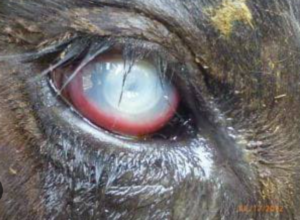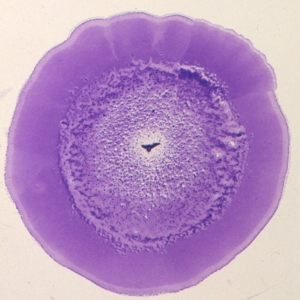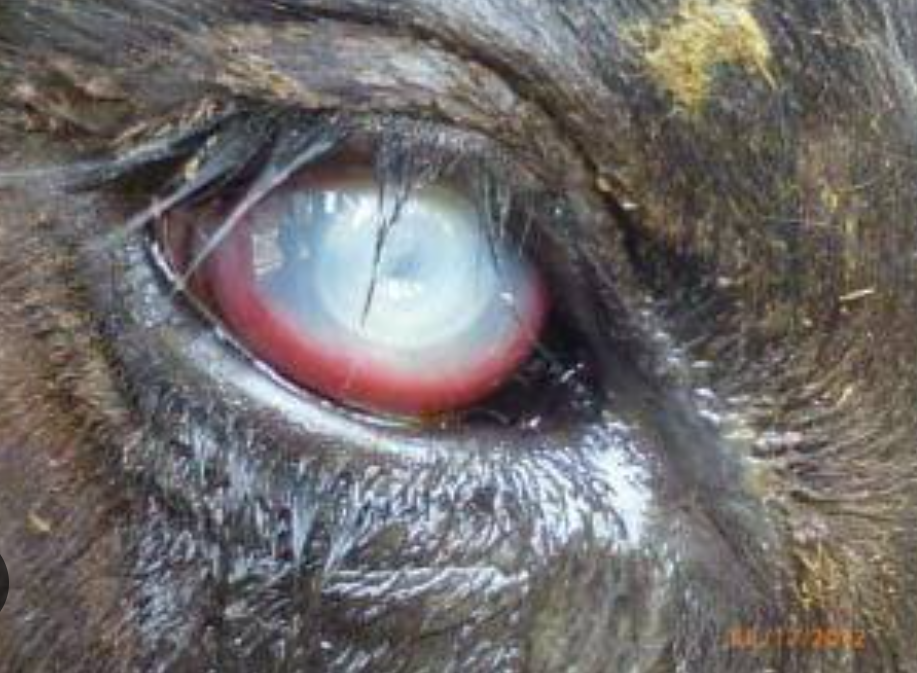Necrobacillosis in cattle, also known as infectious keratitis or “pink eye,” is a common infectious disease that affects the eyes of cattle.Necrobacillosis is highly contagious and often spreads rapidly within a herd, particularly in situations where animals are in close contact or where environmental conditions favor bacterial growth. The disease is characterized by inflammation of the cornea, the transparent outer layer of the eye, leading to symptoms such as redness, tearing, squinting, and sometimes even blindness.

Etiology of Pink Eye:
It is primarily caused bye bacterium Moraxella bovis.

Moraxella bovis is a gram-negative bacterium belonging to the family Moraxellaceae. It is the primary causative agent responsible for the disease in cattle, although other bacteria may also contribute to the condition. Moraxella bovis has evolved mechanisms to colonize and proliferate in the conjunctiva and cornea of affected animals, leading to the characteristic clinical signs and pathological changes associated with Necrobacillosis. Factors such as bacterial virulence factors, host susceptibility, and environmental conditions play a role in the development and severity of the disease.
Risk factors for Pink Eye:
- ultraviolet solar irradiation
- flies
- dust
- mechanical irritation (plant awns such as foxtails)
- trace mineral deficiencies (copper, selenium)
- infectious agents (see below)
- recent commingling via shipping
- attendance at shows/sales/auctions
Distribution of Pink Eye:
It has a global distribution. It can be found in various regions around the world where cattle farming is prevalent. The disease is more common in areas with warm and dry climates, as environmental factors such as excessive sunlight, dust, and irritants contribute to its development. Necrobacillosis can affect both domestic and wild ruminant species. However, the specific prevalence and impact of the disease can vary among different countries and regions depending on factors such as management practices, herd size, environmental conditions, and the presence of effective control measures.

Pathogenesis of Pink Eye:
It involves the entry and colonization of Moraxella bovis bacteria in the eye, leading to their proliferation, corneal damage, and an inflammatory response. The disease is highly contagious and can spread through direct contact and contaminated materials. Prompt veterinary attention and preventive measures are essential to minimize corneal damage, control the spread of the disease, and facilitate recovery in affected animals.
Clinical signs
The clinical signs of necrobacillosis, or infectious keratitis, in cattle can vary in severity but generally involve the eyes. Here are some common clinical signs associated with the disease:
- Redness: The affected eyes may appear red or bloodshot.
- Tearing: Excessive tearing or watery discharge from the eyes is often observed.
- Squinting: Cattle may squint or partially close their affected eye(s) due to pain and discomfort.
- Corneal opacity: The cornea, which is normally clear, may become cloudy or opaque.
- Corneal ulceration: The inflammation can lead to the development of corneal ulcers, which are open sores on the surface of the eye.
- Eyelid swelling: Swelling of the eyelids, either localized or generalized, can occur.
- Photophobia: Affected animals may exhibit sensitivity to light, avoiding bright areas or seeking shade.
- Blinking and rubbing: Cattle may frequently blink or rub their eyes in an attempt to alleviate discomfort.
- Decreased appetite: In severe cases, cattle may show a reduced appetite and decreased overall activity.
- Blindness: In some instances, if left untreated or if complications arise, necrobacillosis can lead to partial or complete blindness in affected animals.
It is important to note that the clinical signs can vary depending on the severity of the infection and the individual response of the animal.
Visit Our website for more detailed discussion about diseases and medicine.
Lesions:
In cattle, one or more small ulcers typically develop near the center of the cornea. Initially, the cornea around the ulcer is clear, but within a few hours a faint haze appears that subsequently increases in opacity. Lesions may regress in the early stages or may continue to progress.
Diagnosis of Pink Eye:
- Clinical signs and microbial culture
Diagnosis of classic bacterial agents such as Moraxella is often by aerobic culture of samples taken from affected eyes.
- PCR can be used to detect Chlamydia and Mycoplasma spp.
Differential Diagnosis of Pink Eye:
Here are some potential differential diagnoses to consider:
- Other infectious causes: Other bacterial or viral infections affecting the eyes, such as bovine viral diarrhea (BVD), infectious bovine rhinotracheitis (IBR), or Mycoplasma bovis infections, can present with similar ocular symptoms.
- Allergic conjunctivitis: Allergic reactions to environmental irritants or allergens can lead to conjunctivitis in cattle, resulting in redness, tearing, and swelling of the eyelids.
- Traumatic injuries: Eye injuries, such as corneal abrasions or foreign body penetration, can cause similar clinical signs to necrobacillosis. It is important to consider the possibility of physical trauma when evaluating eye conditions.
- Uveitis: Uveitis, or inflammation of the inner layers of the eye, can present with signs such as redness, tearing, and squinting. This condition can have various causes, including infectious agents, immune-mediated disorders, or systemic diseases.
- Pink eye caused by other bacteria: While Moraxella bovis is the primary causative agent of necrobacillosis, other bacteria, such as Moraxella bovoculi or Trueperella pyogenes, can also cause similar ocular infections in cattle.
- Chemical irritants: Exposure to irritant chemicals or noxious substances in the environment can lead to eye irritation and conjunctivitis, resembling the clinical signs of necrobacillosis.
Prevention:
- Vaccination: Utilize commercially available vaccines against Moraxella bovis to provide some level of protection.
- Fly control: Implement measures to control flies, such as using insecticides, fly traps, and good waste management practices.
- Environmental management: Minimize eye irritants by providing shade, reducing dust with sprinklers, and maintaining clean and well-ventilated facilities.
- Biosecurity: Practice good biosecurity measures, including quarantine and testing of new animals, as well as proper cleaning and disinfection of equipment and facilities.
- Herd management: Maintain overall herd health through proper nutrition, vaccination protocols, and monitoring for early signs of disease.
Control of Pink Eye:
- Early detection: Regularly monitor the herd for signs of necrobacillosis, such as redness, tearing, and squinting, to enable prompt intervention.
- Isolation and treatment: Isolate affected animals and promptly administer appropriate treatment, including antibiotics and supportive care.
- Environmental hygiene: Maintain clean and hygienic conditions to minimize the spread of the bacteria.
- Monitoring and surveillance: Track disease incidence and prevalence in the herd, and consider participating in regional or national surveillance programs to stay informed about disease trends.
- For more details about Pink eye you can read here( Pink Eye Detailed Article)
Treatment of Pink Eye:
- Pink Eye to control the bacterial infection.
- long-acting oxytetracycline (two injections of 20 mg/kg, IM or SC, at a 48- to 72-hour interval)
- Use topical treatments like ointments or drops to reduce inflammation and promote healing.
- 1% atropine ointment 1–3 times daily
- Provide pain management with NSAIDs if necessary.
- Loxin
- Flu meg
- Vitafenic plus
- Create a clean and well-maintained environment to minimize eye irritation.
- Ensure proper nutrition, hydration, and overall herd health management for supportive care.
Tonics and Multivitamins
- Amivicom
- Aminovital
- Vitamin B13
- Vitamin B-Complex


Mash Allah sir ..its very informative
Good information Sir 🌹
Informative content
Informative
Doing great work sir 😍
❣️❣️❣️